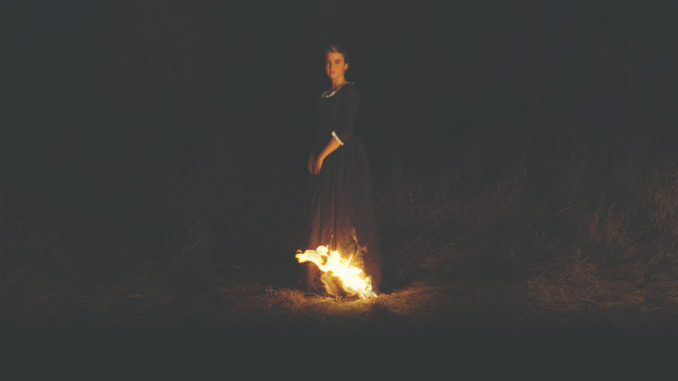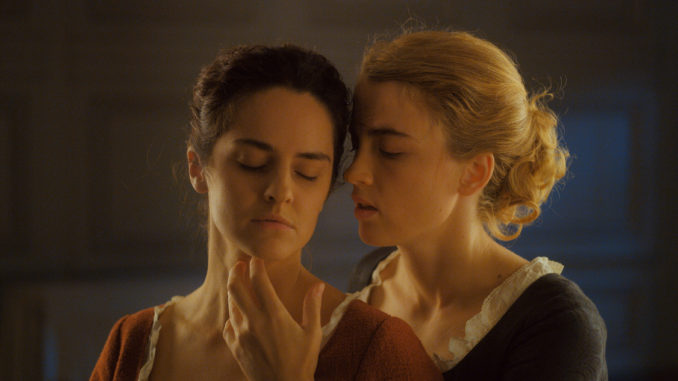
After appearing at the Cannes Film Festival in mid-2019 to much critical acclaim, director Céline Sciamma released “Portrait of a Lady on Fire” in her home country of France. The film premiered at multiple festivals around the world before finally releasing to theaters in the United States on Valentine’s Day 2020. It was lauded for its painterly visuals, purposeful cinematography and passionately literate screenplay, receiving the Best Screenplay accolade at Cannes. For this entry into my column, I take a look at an untraditional romance film overlooked by many but no doubt deserving of their praise.
“Portrait of a Lady on Fire” follows professional painter Marianne, a meek woman often hired for her remarkable skills as a portraitist. At the end of the 18th century, a French noblewoman recruits Marianne to paint a portrait of her daughter and heiress, Héloïse, and invites Marianne to their remote estate on an island in Brittany. The portrait is to serve as a sort of dowry for Héloïse’s suitor, a Milanese nobleman she does not know. The only catch: Marianne must paint the portrait without Héloïse finding out. No extended posing sessions — only memories and stolen glances. So begins the film’s initial drama — Marianne’s attempts at recreating Héloïse’s likeness in a most unconventional manner. On the eve of Marianne’s departure, after daily strolls filled with haphazard charcoal scribblings of the ear, the neck, the hands, Héloïse discovers Marianne’s purpose and, rather than electing to an outrage, agrees to pose for her — the secondary and most central drama. What develops from this drama is a secret romance between the two women, at a time when such relationships were condemned. The mounting pressure of Héloïse’s unwanted betrothal and Marianne’s inevitable departure are tied to the portrait’s completion, a portrait that will create as much as it will destroy.

“Portrait of a Lady on Fire” is a story that has a lot to say about tradition, freedom and, most centrally, love. Sciamma tackles each topic with the grace and confidence of a filmmaking veteran. She keenly understands the craft through her use of meaningful framing, stunning color, symbolic dialogue and nuanced characterization.
Allow me to gush for a moment. There is one specific instance where the framing is most ingenious. Before we meet Héloïse, we learn that, when the last portraitist attempted to paint her likeness, she refused to show her face. Appropriately, when we do meet Héloïse, Sciamma does not allow us to glimpse anything but the back of her head as she begins her first of many strolls with Marianne. Simple, but an immediate enough connection that the audience can revel in its execution.
“Portrait of a Lady on Fire” is simply gorgeous. Reminiscent of its subject matter, each frame and locale looks and feels like a painting. Cinematographer Claire Mathon should be especially commended for her contributions as she, alongside Sciamma’s framing, furthers the film’s identity as a work of art itself. Moreover, designer Dorothée Guiraud’s costuming is likewise contributive. The dresses and outfits are striking and distinct, from their individual colors to their existence in scene-by-scene context where they often juxtapose the drab of the estate interior.

Furthermore, Sciamma’s writing makes use of interesting literary parallels. In one scene, Héloïse narrates the Ancient Greek tragedy in which the mythical Orpheus travels to the underworld to free his wife, Eurydice. There, Hades agrees to release Eurydice, but, in their departure from his domain, Orpheus must not look back at his wife as she trails behind him, or else she will be pulled back. Orpheus, of course, looks back to check on Eurydice, at which point she meets her damnation. Héloïse, Marianne and the handmaid, Sophie, speculate as to why Orpheus, knowing the consequences of looking back, would do so anyway. The scene ends when Marianne suggests that, perhaps, Orpheus made a choice — he chose “the memory of her. That’s why he turns.” Sciamma’s inclusion of this story in the context of Marianne and Héloïse’s forbidden, and ultimately doomed, relationship is clear. The memory of each other is all either woman can hope for.
Sciamma’s nuanced characterization of Marianne and Héloïse comes to life through their performances. Noémie Merlant as Marianne is excellent, portraying a character who, at first impression, is meek and reluctant but sheds that skin as the story unfolds. Adèle Haenel as Héloïse is equally realized, embodying a character who is tortured but loving — breaking, but ultimately hopeful. Both characters present their own duality that Merlant and Haenel balance inerrantly. Their chemistry is a joy to witness.
In short, “Portrait of a Lady on Fire” is brilliant. Sciamma and her crew craft a film teeming with passion and lively with social commentary. While the inevitability of Marianne and Héloïse’s separation is bleak, I was left with a warm hopefulness by the end of the film’s comfortable two-hour runtime. Real and beautiful, “Portrait of a Lady on Fire” is nothing short of a work of art.
